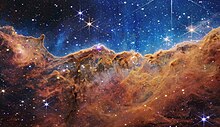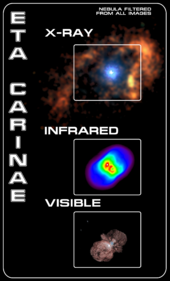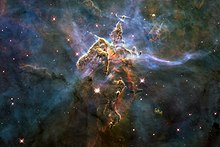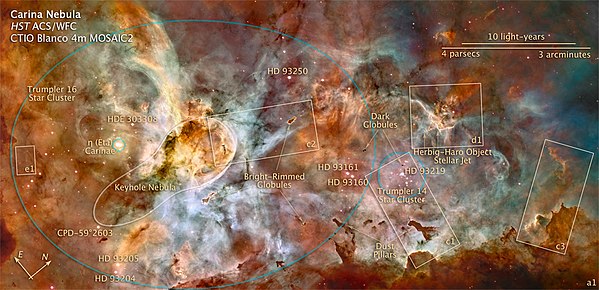Carina Nebula
arcmins | |
|---|---|
| Constellation | Carina |
| Physical characteristics | |
| Radius | ~230[4] ly (~70 pc) |
| Notable features |
|
| Designations | NGC 3372,[5] ESO 128-EN013,[1] GC 2197,[1] h 3295,[1] Caldwell 92[6] |

The Carina Nebula
The nebula has within its boundaries the large
are also considered members of the association. NGC 3293 is the oldest and furthest from Trumpler 14, indicating sequential and ongoing star formation.The nebula is one of the largest diffuse nebulae in our skies. Although it is four times as large as and even brighter than the famous Orion Nebula, the Carina Nebula is much less well known due to its location in the southern sky. It was discovered by Nicolas-Louis de Lacaille in 1752 from the Cape of Good Hope.
The Carina Nebula was selected as one of five cosmic objects observed by the James Webb Space Telescope, as part of the release of its first official science images. A detailed image was made of an early star-forming region of NGC 3324 known as the Cosmic Cliffs.[10]
Discovery and basic information
Objects within the Carina Nebula
Eta Carinae

Eta Carinae is a highly luminous hypergiant star. Estimates of its mass range from 100 to 150 times the mass of the Sun, and its luminosity is about four million times that of the Sun.
This object is currently the most massive star that can be studied in great detail, because of its location and size. Several other known stars may be
Eta Carinae's effects on the nebula can be seen directly. Dark globules and some other less visible objects have tails pointing directly away from the massive star. The entire nebula would have looked very different before the Great Eruption in the 1840s surrounded Eta Carinae with dust, drastically reducing the amount of ultraviolet light it put into the nebula.
Homunculus Nebula

Within the large bright nebula is a much smaller feature, immediately surrounding Eta Carinae itself, known as the Homunculus Nebula (from Latin meaning Little Man). It is believed to have been ejected in an enormous outburst in 1841 which briefly made Eta Carinae the second-brightest star in the sky.
The Homunculus Nebula is a small H II region, with gas shocked into ionized and excited states.[11] It also absorbs much of the light from the extremely luminous central stellar system and re-radiates it as infrared (IR). It is the brightest object in the sky at mid-IR wavelengths.[12]: 145–169
The distance to the Homunculus can be derived from its observed angular dimensions and calculated linear size, assuming it is axially symmetric. The most accurate distance obtained using this method is 7,660 ± 160 light-years (2,350 ± 50 pc). The largest radius of the bipolar lobes in this model is about 22,000 AU, and the axis is oriented 41° from the line of sight, or 49° relative to the plane of the sky, which means it is seen from Earth slightly more "end on" than "side on".[13]
Keyhole Nebula

The Keyhole, or Keyhole Nebula, is a small dark cloud of cold molecules and dust within the Carina Nebula, containing bright filaments of hot, fluorescing gas, silhouetted against the much brighter background nebula.
The diameter of the Keyhole structure is approximately seven light-years (2.1 pc). Its appearance has changed significantly since it was first observed, possibly due to changes in the ionizing radiation from Eta Carinae.[20] The Keyhole does not have its own NGC designation. It is sometimes erroneously called NGC 3324,[21] but that catalogue designation refers to a reflection and emission nebula just northwest of the Carina Nebula (or to its embedded star cluster).[22][23][24]
Defiant Finger

A small Bok globule in the Keyhole Nebula (at RA 10h 44m 30s, Dec −59° 40') has been photographed by the Hubble Space Telescope and is nicknamed the "Carina Defiant Finger" due to its shape.[25] In Hubble images, light can be seen radiating off the edges of the globule; this is especially visible in the southern tip, where the "finger" is. It is thought that the Defiant Finger is being ionized by the bright Wolf–Rayet star WR 25, and/or Trumpler 16-244, a bright blue supergiant. It has a mass of at least 6 M☉, and stars may be forming within it. Like other interstellar clouds under intense radiation, the Defiant Finger will eventually be completely evaporated; for this cloud the time frame is predicted to be 200,000 to 1,000,000 years.[26]
Trumpler 14

Trumpler 14 is an open cluster with a diameter of six light-years (1.8 pc), located within the inner regions of the Carina Nebula, approximately 8,000 light-years (2,500 pc) from Earth.[27] It is one of the main clusters of the Carina OB1 stellar association, which is the largest association in the Carina Nebula.[12] About 2,000 stars have been identified in Trumpler 14.[28] and the total mass of the cluster is estimated to be 4,300 M☉.[29]
Trumpler 15
Trumpler 15 is a star cluster on the north-east edge of the Carina Nebula. Early studies disagreed about the distance, but astrometric measurements by the Gaia mission have confirmed that it is the same distance as the rest of Carina OB1.[2]
Trumpler 16
Trumpler 16 is one of the main clusters of the Carina OB1 stellar association, which is the largest association in the Carina Nebula, and it is bigger and more massive than Trumpler 14.[12] The star Eta Carinae is part of this cluster.
Mystic Mountain

Mystic Mountain is the term for a dust–gas pillar in the Carina Nebula, a photo of which was taken by Hubble Space Telescope on its 20th anniversary. The area was observed by Hubble's Wide Field Camera 3 on 1–2 February 2010. The pillar measures three light-years (0.92 pc) in height; nascent stars inside the pillar fire off gas jets that stream from towering “peaks”.
WR 22
WR 22 is an eclipsing binary. The dynamical masses derived from orbital fitting vary from over 70 M☉ to less than 60 M☉ for the primary and about 21 to 27 M☉ for the secondary.[30] The spectroscopic mass of the primary has been calculated at 74 M☉[31] or 78.1 M☉.[32]
WR 25

WR 25 is a binary system in the central portion of the Carina Nebula, a member of the Trumpler 16 cluster. The primary is a Wolf–Rayet star, possibly the most luminous star in the galaxy. The secondary is hard to detect but thought to be a luminous OB star.
HD 93129
HD 93129 is a triple star system of O-class stars in Carina. All three stars of HD 93129 are among the most luminous in the galaxy;[33] HD 93129 consists of two clearly resolved components, HD 93129 A and HD 93129 B, and HD 93129 A itself is made up of two much closer stars.
HD 93129 A has been resolved into two components. The spectrum is dominated by the brighter component, although the secondary is only 0.9 magnitudes fainter. HD 93129 Aa is an O2 supergiant and Ab is an O3.5 main sequence star.
HD 93129 B is an
HD 93250
HD 93250 is one of the brightest stars in the region of the Carina Nebula. It is only 7.5
HD 93250 is known to be a binary star, however, individual spectra of the two components have never been observed but are thought to be very similar. The spectral type of HD 93250 has variously been given as O5,[40] O6/7,[41] O4,[42] and O3.[43] It has sometimes been classified as a main sequence star and sometimes as a giant star.[42][43] The Galactic O-Star Spectroscopic Survey has used it as the standard star for the newly created O4 subgiant spectral type.[44]
HD 93205
HD 93205 is a binary system of two large stars.
The more massive member of the pair is an O3.5 main sequence star. The spectrum shows some ionized nitrogen and helium emission lines, indicating some mixing of fusion products to the surface and a strong stellar wind. The mass calculated from apsidal motion of the orbits is 40 to 60 M☉. This is somewhat lower than expected from evolutionary modelling of a star with its observed parameters.[45]
The less massive member is an O8 main sequence star of approximately 20 M☉.[46] It moves in its orbit at a speed of over 300 km/s (190 mi/s) and is considered to be a relativistic binary, which causes the apses of the orbit to change in a predictable way.[47]
Catalogued open clusters in Carina Nebula
As of 1998[update], there are eight known open clusters in the Carina Nebula:[3]
- Bochum 10 (Bo 10)
- Bochum 11 (Bo 11)
- Collinder 228 (Cr 228)[48]
- Collinder 232 (Cr 232)
- Collinder 234 (Cr 234)
- Trumpler 14 (Tr 14, Cr 230)
- Trumpler 15 (Tr 15, Cr 231)
- Trumpler 16 (Tr 16, Cr 233)
Annotated map


Gallery
-
Overview of the Carina Nebula. The Keyhole is superimposed on the bright area above center, and Eta Carinae is the bright star just to its left.
-
Carina Nebula in infrared light[50]
-
X-rays from stars and diffuse multimillion-Kelvin plasma light up the Carina Nebula in this Chandra X-ray Observatory image
-
Close-up of the Carina Nebula's central region
-
Wolf–Rayet star WR 22
-
Bok globule nicknamed "The Caterpillar"[51]
-
Region R44 in the Carina Nebula[52]
-
Scientists taking a “deep dive” into one of the iconic first images from the James Webb Space Telescope have discovered dozens of energetic jets and outflows from young stars previously hidden by dust clouds. [53]
See also
References
- ^ The NGC/IC Project. Archived from the originalon 28 May 2009. Retrieved 29 November 2016.
- ^ S2CID 119328315.
- ^ a b c Frommert, Hartmut & Kronberg, Christine (22 March 1998). "NGC 3372". SEDS.org. Archived from the original on 30 May 2016. Retrieved 26 November 2016.
- ^ "NGC 3372 – The Eta Carinae Nebula". Atlas of the Universe. Retrieved 1 October 2013.
- ^ "NGC 3372". SIMBAD. Centre de données astronomiques de Strasbourg. Retrieved 3 September 2013.
- ISBN 978-0-521-82796-6.
- ^ "The Carina Nebula: Star Birth in the Extreme". Hubblesite. NASA. 24 April 2007. Retrieved 20 November 2020.
- ^ Uranometria 2000.0
- ^ Garner, Rob (8 July 2022). "NASA Shares List of Cosmic Targets for Webb Telescope's 1st Images". NASA. Retrieved 8 July 2022.
- S2CID 2460614.
- ^ ISBN 978-1-4614-2274-7.
- S2CID 12453761.
- OCLC 5045340.
- .
- Bibcode:1873AReg...11..221A.
- ^ Converse, Emma M. (27 December 1873). "Eta Argûs". Appletons' Journal. 10 (249): 818.
- .
- ISBN 978-0-486-23567-7.
- Bibcode:1977S&T....54...22W.
- ^ For example, see APOD – NGC 3324.
- ISBN 978-0-943396-89-7.
- The NGC/IC Project. Archived from the originalon 28 May 2009. Retrieved 17 May 2014.
- ^ "NGC 3324". SIMBAD. Centre de données astronomiques de Strasbourg. Retrieved 17 May 2014.
- ^ "NAME Carina Defiant Finger". SIMBAD. Centre de données astronomiques de Strasbourg. Retrieved 3 April 2020.
- S2CID 14709621.
- S2CID 18502004.
- Bibcode:2009eso..pres...47.Science Release eso0947.
- S2CID 119294869.
- Bibcode:1999A&A...347..127S.
- S2CID 18714731.
- S2CID 16025012.
- S2CID 8258609.
- S2CID 18416034.
- S2CID 53500788.
- Bibcode:2000A&A...355L..27H.
- Bibcode:1996A&AS..116...75V.
- S2CID 119215270.
- S2CID 14060690.
- Bibcode:1973MmRAS..77..199T.
- ISBN 978-0-8357-0331-4.
- ^ S2CID 119122481.
- ^ .
- S2CID 55658165.
- S2CID 16834579.
- S2CID 117107602.
- S2CID 16221731.
- ^ Frommert, Hartmut & Kronberg, Christine (6 May 2001). "Collinder 228". SEDS.org. Retrieved 29 November 2016.
- ^ "The Carina Nebula: Star Birth in the Extreme". The Hubble Heritage Project. Space Telescope Science Institute. 24 April 2007. Retrieved 14 August 2023.
- ^ "Stars v. Dust in the Carina Nebula". European Southern Observatory. 29 August 2018. Retrieved 30 August 2018.
- ^ "Carina Nebula Details: The Caterpillar". Hubblesite. Space Telescope Science Institute. 24 April 2007. Retrieved 14 August 2023.
- ^ "Pillars of Destruction". European Southern Observatory. 2 November 2016. Retrieved 7 December 2016.
- ^ "Carina Nebula Jets (NIRCam Narrowband Filters - Annotated)". 18 October 2023.
External links
- Carina Nebula at SEDS.org
- Carina Nebula at Atlas of the Universe
- Carina Nebula at Constellation Guide
- Carina Nebula on


![Carina Nebula in infrared light[50]](http://upload.wikimedia.org/wikipedia/commons/thumb/b/bf/The_Carina_Nebula_in_infrared_light.jpg/112px-The_Carina_Nebula_in_infrared_light.jpg)



![Bok globule nicknamed "The Caterpillar"[51]](http://upload.wikimedia.org/wikipedia/commons/thumb/d/d5/Hs-2007-16-e-800x800.jpg/120px-Hs-2007-16-e-800x800.jpg)
![Scientists taking a “deep dive” into one of the iconic first images from the James Webb Space Telescope have discovered dozens of energetic jets and outflows from young stars previously hidden by dust clouds. [53]](http://upload.wikimedia.org/wikipedia/commons/thumb/d/d1/Carina_Nebula_Jets_%28NIRCam_Narrowband_Filters_-_Annotated%29_%28carinanebula1%29.jpeg/120px-Carina_Nebula_Jets_%28NIRCam_Narrowband_Filters_-_Annotated%29_%28carinanebula1%29.jpeg)